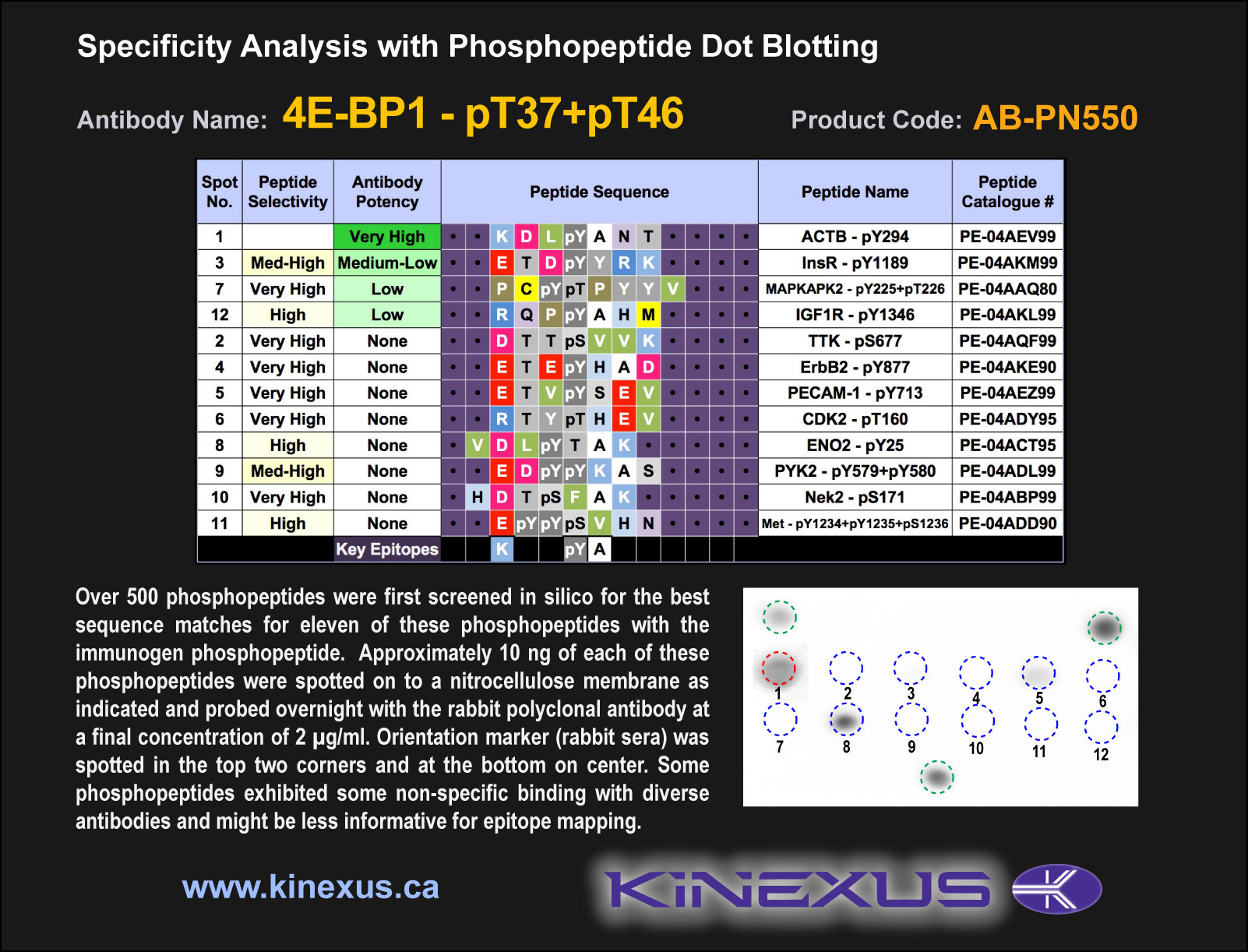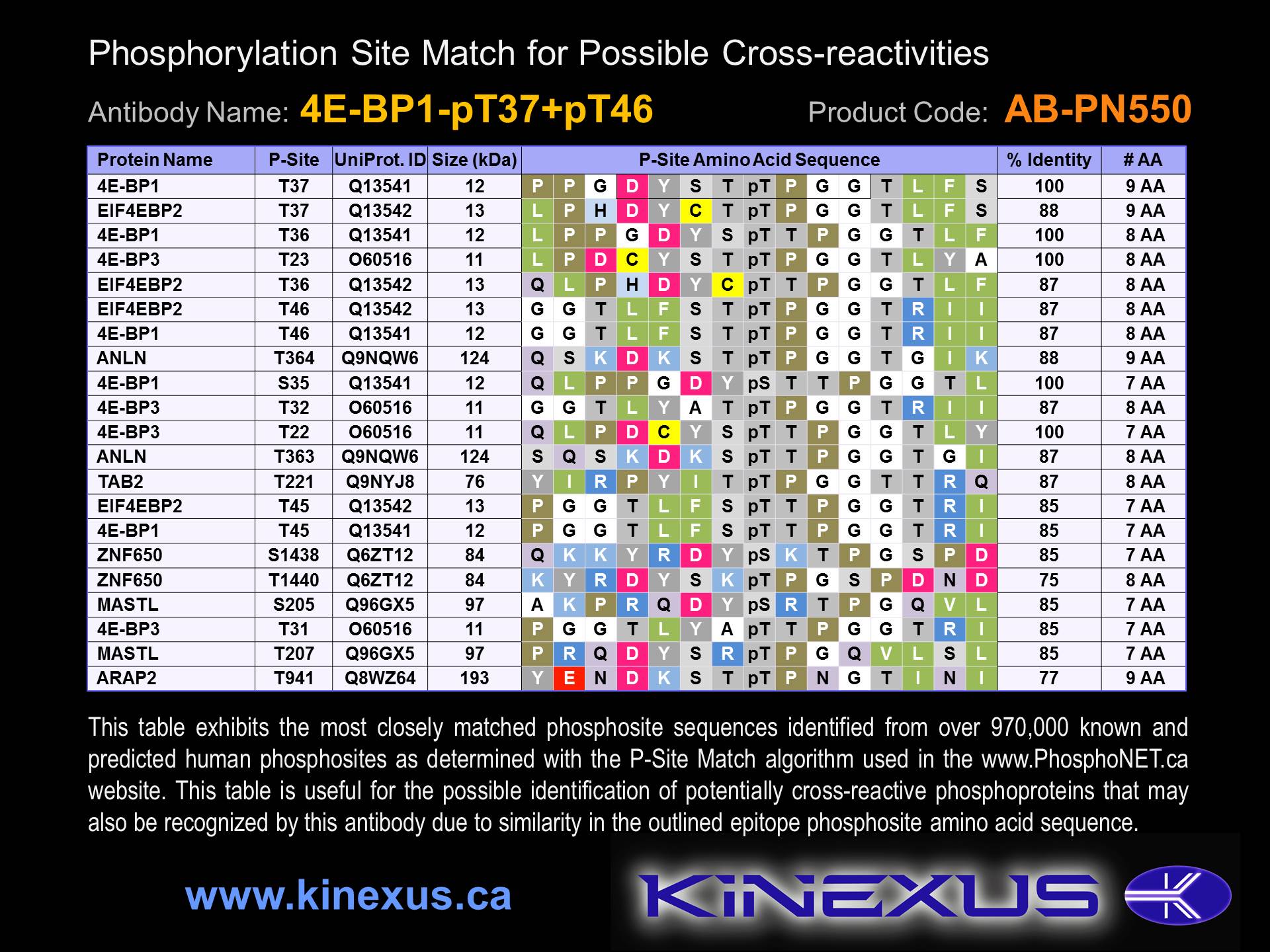Product Name: 4E-BP1-pT37+pT46
Product Number: AB-PN550
| Size: | 25 µg | Price: | 89.00 | |
| $US |
Target Full Name: 4E transcription factor binding protein 1
Target Alias: 4EBP1; EIF4EBP1; Eukaryotic translation initiation factor 4E binding protein 1; Insulin-stimulated EIF-4E binding protein PHAS-I; P,OKCL.6; P/OKCL.6; PHAS-1; PHAS-I; Phosphorylated heat- and acid-stable protein regulated by insulin 1
Product Type Specific: Protein translation protein phosphosite-specific antibody
Antibody Code: PN550
Antibody Target Type: Phosphosite-specific
Antibody Phosphosite: T37+T46
Protein UniProt: Q13541
Protein SigNET: Q13541
Antibody Type: Polyclonal
Target Alias: 4EBP1; EIF4EBP1; Eukaryotic translation initiation factor 4E binding protein 1; Insulin-stimulated EIF-4E binding protein PHAS-I; P,OKCL.6; P/OKCL.6; PHAS-1; PHAS-I; Phosphorylated heat- and acid-stable protein regulated by insulin 1
Product Type Specific: Protein translation protein phosphosite-specific antibody
Antibody Code: PN550
Antibody Target Type: Phosphosite-specific
Antibody Phosphosite: T37+T46
Protein UniProt: Q13541
Protein SigNET: Q13541
Antibody Type: Polyclonal
Antibody Host Species: Rabbit
Antibody Immunogen Source: Human 4E-BP1 (PHAS1) sequence peptide Cat. No.: PE-04AQU90
Antibody Immunogen Sequence: DYST(pT)PGG(bA)C
Antibody Immunogen Description: Corresponds to amino acid residues D33 to G40; In the N-terminal portion of the translation regulatory protein. This is one of the major in vivo phosphorylation sites in 4E-BP1.
Antibody Immunogen Source: Human 4E-BP1 (PHAS1) sequence peptide Cat. No.: PE-04AQU90
Antibody Immunogen Sequence: DYST(pT)PGG(bA)C
Antibody Immunogen Description: Corresponds to amino acid residues D33 to G40; In the N-terminal portion of the translation regulatory protein. This is one of the major in vivo phosphorylation sites in 4E-BP1.
Production Method: The immunizing peptide was produced by solid phase synthesis on a multipep peptide synthesizer and purified by reverse-phase hplc chromatography. Purity was assessed by analytical hplc and the amino acid sequence confirmed by mass spectrometry analysis. This peptide was coupled to KLH prior to immunization into rabbits. New Zealand White rabbits were subcutaneously injected with KLH-coupled immunizing peptide every 4 weeks for 4 months. The sera from these animals was applied onto an agarose column to which the immunogen peptide was thio-linked. Antibody was eluted from the column with 0.1 M glycine, pH 2.5. Subsequently, the antibody solution was neutralized to pH 7.0 with saturated Tris.This antibody was also subject to negative purification over phosphotyrosine-agarose.
Antibody Modification: Unconjugated. Contact KInexus if you are interest in having the antibody biotinylated or coupled with fluorescent dyes.
Antibody Modification: Unconjugated. Contact KInexus if you are interest in having the antibody biotinylated or coupled with fluorescent dyes.
Antibody Concentration: 1 mg/ml
Storage Buffer: Phosphate buffered saline pH 7.4, 0.05% Thimerasol
Storage Conditions: For long term storage, keep frozen at -40°C or lower. Stock solution can be kept at +4°C for more than 3 months. Avoid repeated freeze-thaw cycles.
Product Use: Western blotting | Antibody microarray
Antibody Dilution Recommended: 2 µg/ml for immunoblotting
Storage Buffer: Phosphate buffered saline pH 7.4, 0.05% Thimerasol
Storage Conditions: For long term storage, keep frozen at -40°C or lower. Stock solution can be kept at +4°C for more than 3 months. Avoid repeated freeze-thaw cycles.
Product Use: Western blotting | Antibody microarray
Antibody Dilution Recommended: 2 µg/ml for immunoblotting
Antibody Potency: No significant cross-reactive proteins detected in phenylarsine oxide (PAO)+vanadate-treated HeLa cells, EGF-treated A431 cells and insulin-treated MCF7 cells, when these cells were homogenized in SDS-PAGE sample buffer.The observed molecular mass of the processed target protein on SDS-PAGE gels is reported to be around 16-18 kDa.Unconjugated. Contact KInexus if you are interest in having the antibody biotinylated or coupled with fluorescent dyes.
Antibody Species Reactivity: Human
Antibody Positive Control: The observed molecular mass of the processed target protein on SDS-PAGE gels is reported to be around 16-18 kDa.
Antibody Specificity: Very high
Antibody Species Reactivity: Human
Antibody Positive Control: The observed molecular mass of the processed target protein on SDS-PAGE gels is reported to be around 16-18 kDa.
Antibody Specificity: Very high
Antibody Cross Reactivity: No significant cross-reactive proteins detected in phenylarsine oxide (PAO)+vanadate-treated HeLa cells, EGF-treated A431 cells and insulin-treated MCF7 cells, when these cells were homogenized in SDS-PAGE sample buffer.
Related Product 1: 4E-BP1-pT37+pT46 blocking peptide
Related Product 2: 4E-BP1 pT45 phosphosite-specific antibody (Cat. No.:AB-PN114)
Related Product 1: 4E-BP1-pT37+pT46 blocking peptide
Related Product 2: 4E-BP1 pT45 phosphosite-specific antibody (Cat. No.:AB-PN114)
Scientific Background: 4E-BP1 (PHAS-1) acts downstream of the MAP kinase and TORC1 signalling pathways to inhibit EIF4E activity to promote translation initiation by preventing its assembly into the eIF4F complex. The hypophosphorylated form of 4E-BP1 competes with EIF4G1/EIF4G3 and strongly binds to EIF4E to repress translation. The hyperphosphorylated form of 4E-BP1 dissociates from EIF4E, and permits interaction between EIF4G1/EIF4G3 and EIF4E, leading to initiation of translation.
Figure 1. Epitope mapping of 4E-BP1-pT37+pT46 antibody with similar phosphopeptides on dot blots.
Figure 2. Identification of phosphosites related to 4E-BP1-pT37+pT46.
© Kinexus Bioinformatics Corporation 2017



